The Old Testament is rich in the accounts of courageous, kind, and beautiful women. The same is true of the women of the New Testament. They shaped history with their influence, spirituality, and yes, their scheming. These ten artists have made the scriptures come alive and added an additional dimension to the Old Testament.
Rachel
The younger of the daughters of Laban, the dearly loved wife of Jacob, and mother of Joseph and Benjamin (Gen. 29 – 31; Gen. 33: 1-2, 7; Gen. 35: 16, 24-25; Gen. 46: 19, 22, 25); her grave (Gen. 35: 19-20; Gen. 48: 7; 1 Sam. 10: 2). Jeremiah, in a very beautiful passage, pictures Rachel as weeping in Ramah for her children, the descendants of Benjamin, Ramah being the place at which the exiles were assembled before their departure for Babylon (Jer. 31: 15). Matthew quotes the passage in his description of the mourning at Bethlehem (where Rachel’s grave was) after the murder of the children (Matt. 2: 18). — LDS Bible Dictionary
Josef von Führich
Deeply impressed as a boy by rustic pictures adorning the wayside chapels of his native country, his first attempt at composition was a sketch of the Nativity for the festival of Christmas in his father’s house. He lived to see the day when, becoming celebrated as a composer of scriptural episodes, his sacred subjects were transferred in numberless repetitions to the roadside churches of the Austrian state, where humble peasants thus learnt to admire modern art reviving the models of earlier ages. — Wikipedia
Image source: Web Gallery of Art
Rebekah
Daughter of Bethuel and sister of Laban; married to Isaac (Gen. 22: 23; Gen. 24); mother of Esau and Jacob (Gen. 25: 20-28); pretends to be Isaac’s sister (Gen. 26: 7, 8); angry with Esau (Gen. 26: 35), and helps to obtain the blessing for Jacob (Gen. 27; Gen. 28: 5; Gen. 29: 12); her grave (Gen. 49: 31); her nurse (Gen. 24: 59; Gen. 35: 8). — LDS Bible Dictionary
Michael Deas
No information.
Image source: Gospel Art — Old Testament
Abigail
Wife of Nabal (1 Sam. 25: 3); became David’s wife (1 Sam. 25: 42; 1 Sam. 27: 3; 1 Sam. 30: 5; 2 Sam. 2: 2); mother of Chileab (2 Sam. 3: 3), or Daniel (1 Chr. 3: 1). — LDS Bible Dictionary
Jacob Willemsz de Wet the Elder
Dutch, born Haarlem, circa 1610-1675. His works were largely influenced by Rembrandt. The Great Gallery of the Palace of Holyroodhouse in Edinburgh was decorated with Jacob de Wet’s portraits of Scottish monarchs, from the legendary King Fergus to Charles II, produced to the order of King Charles. De Wet taught a number of painters, most famously Paulus Potter. Other pupils were Jan Vermeer van Haarlem the Elder and Job Adriaenszoon Berckheyde. — Wikipedia
Image source: Web Gallery of Art
Esther
The Book of Esther contains the history that led to the institution of the Jewish feast of Purim. The story belongs to the time of the Captivity. Ahasuerus, king of Persia (most probably Xerxes), had decided to divorce his queen Vashti because she refused to show her beauty to the people and the princes. Esther, adopted daughter of Mordecai the Jew, was chosen as her successor, on account of her beauty. Haman, chief man at the king’s court, hated Mordecai, and having cast lots to find a suitable day, obtained a decree to put all Jews to death. Esther, at great personal risk, revealed her own nationality and obtained a reversal of the decree. It was decided that two days of feasting should be annually observed in honor of this deliverance. They were called, because of the lot (Pur) that Haman had cast for the destruction of the Jews.
The book contains no direct reference to God, but he is everywhere taken for granted, as the book infers a providential destiny (Esth. 4: 13-16), and speaks of fasting for deliverance. There have been doubts at times as to whether it should be admitted to the canon of scripture. But the book has a religious value as containing a most striking illustration of God’s overruling providence in history, and as exhibiting a very high type of courage, loyalty, and patriotism. — LDS Bible Dictionary
Minerva Teichert
Teichert was born in Ogden, Utah and grew up on a ranch in Idaho as the second of nine children. She studied at the Art Institute of Chicago under John Vanderpoel, and then at the Art Students League of New York under Robert Henri.
She married Herman Teichert and raised five children on a ranch in Cokeville, Wyoming while painting the things she knew and loved best: Scenes from western Americana, and religious artwork expressing her deeply held convictions. She once explained “I must paint”, when asked about how she persisted in painting despite being in near-complete artistic isolation, without a dedicated studio or even much free time to create. Teichert was an independent, opinionated woman who stood up for women’s rights and was an outspoken political conservative. Teichert died in Provo, Utah in 1976. — Wikipedia
Fredrick Teichert writes:
She never received any money from the LDS Church to support her art studies. She supported herself by homesteading and teaching school, one of the reasons, it took her longer than she would have liked to develop her craft. Furthermore, the vast majority of paintings now owned by the church were not purchased, but donated to it by her or by members of her family. This is important because it helps those who appreciate her work understand the nature of her devotion to the gospel and her personal “mission.” All of her work was accomplished at great personal sacrifice, in fact she sold cream, butter and eggs raised on the family ranch, in order to be able to purchase art supplies. See Comments.
Also see: Jan Underwood Pinborough, “Minerva Kohlhepp Teichert: With a Bold Brush“, Ensign, Apr. 1989, 34
Image source: Gospel Art — Old Testament
Miriam
Sister of Moses (Num. 26: 59); watches the ark of bulrushes (Ex. 2: 4-8); leads the women with tabrets (Ex. 15: 20-21); murmurs against Moses and is smitten with leprosy (Num. 12: 1-15; Deut. 24: 9); dies in Kadesh (Num. 20: 1; Micah 6: 4). — LDS Bible Dictionary
Anselm Friedrich Feuerbach
Anselm Feuerbach was the leading classicist painter of the German 19th-century school. He was the first to realize the danger arising from contempt of technique, that mastery of craftsmanship was needed to express even the loftiest ideas, and that an ill-drawn coloured cartoon can never be the supreme achievement in art.
After having passed through the art schools of Düsseldorf and Munich, he went to Antwerp and subsequently to Paris, where he benefited by the teaching of Couture, and produced his first masterpiece, Hafiz at the Fountain in 1852. He subsequently worked at Karlsruhe, Venice, Rome and Vienna where he associated with Johannes Brahms. He was steeped in classic knowledge, and his figure Compositions have the statuesque dignity and simplicity of Greek art. Disappointed with the reception given in Vienna to his design of The Fall of the Titans for the ceiling of the Museum of Modelling, he went to live in Venice, where he died in 1880. — Wikipedia
Image source: Web Gallery of Art
Eve
The name given in Gen. 2: 21-22; Gen. 3: 20 to the first woman; see also Gen. 3 (cf. 2 Cor. 11: 3; 1 Tim. 2: 13); Gen. 4: 1, 25. The name means “the mother of all living” (Moses 4: 26; cf. 1 Ne. 5: 11). She was the wife of Adam and will share eternal glory with him. Eve’s recognition of the necessity of the fall and the joys of redemption is recorded in Moses 5: 11. Latter-day revelation confirms the biblical account of Eve and gives us an awareness of her nobility. — LDS Bible Dictionary
Joseph Brickey
Writes Jenifer Swindle: Each artist is as unique as the art that he creates. And so is his studio. Joseph’s studio walls are covered with small, magazine cutouts of all his favorite pieces, some by classics like Valesquez and Rembrandt, others with contemporary paintings by fellow artists and friends. Joseph is built like a football player, has an easy smile and a calm disposition. He is artist through and through. During our interview, he told me, “This is what I think about all day long. This is all I want to do. Nothing can pull me away from this except my family. And that is the only thing more important.” — Meridian Magazine, “Art that Connects the Senses and the Spirit”
Image source: Ensign Magazine
Hannah
Mother of Samuel, who was given to her in answer to prayer (1 Sam. 1: 2 – 2: 21). Her song of thanksgiving may be compared with that of Mary (Luke 1: 46-55). It contains the first reference to the title Messiah (“his Anointed”) (1 Sam. 2: 10). — LDS Bible Dictionary
Gerbrand van den Eeckhout
Arnold Houbraken records Van den Eeckhout was a pupil of Rembrandt. A fellow pupil to Ferdinand Bol, Nicolaes Maes and Govert Flinck, he was regarded as inferior to them in skill and experience. He soon assumed Rembrandt’s manner with such success that his pictures were confused with those of his master.
Eeckhout does not merely copy the subjects; he also takes the shapes, the figures, the Jewish dress and the pictorial effects of his master. It is difficult to form an exact judgment of Eeckhout’s qualities at the outset of his career. His earliest pieces are probably those in which he more faithfully reproduced Rembrandt’s peculiarities. Exclusively his is a tinge of green in shadows marring the harmony of the work, a gaudiness of jarring tints, uniform surface and a touch more quick than subtle. — Wikipedia
Image source: Wikipedia
Ruth
The book of Ruth is the history of the family of Elimelech, who in the days of the Judges, because of a famine, went away from Bethlehem to dwell in the land of Moab. There his two sons married Moabite wives, and died, as did also their father. Naomi, the mother, returned to Bethlehem, and Ruth, one of her widowed daughters-in-law, came with her. Ruth, when gleaning in the field of Boaz, a kinsman of Elimelech, found favor with him. Naomi planned that Boaz should marry Ruth, and he was ready to do so, if a nearer kinsman, to whom the right belonged according to the law in Deut. 25: 5-10, declined. He did decline, and so Ruth became the wife of Boaz. Her son was Obed, the father of Jesse, the father of David. The book appears to be intended to connect the history of David with the earlier times, and also to form a contrast, in its peaceful and pastoral simplicity, to the disorders of which we read so continually in the Book of Judges. — LDS Bible Dictionary
Julius Schnorr von Carolsfeld
Schnorr was a Lutheran, and took a broad and un-sectarian view which won for his Pictorial Bible ready currency throughout Christendom.
Frequently the compositions are crowded and confused, wanting in harmony of line and symmetry in the masses; thus they suffer under comparison with Raphael’s “Bible”. The style is severed from the simplicity and severity of early times, and surrendered to the florid redundance of the later Renaissance. Yet throughout are displayed fertility of invention, academic knowledge with facile execution.
The painter’s renown in Germany secured commissions in Great Britain. Schnorr made designs, carried out in the royal factory, Munich, for windows in Glasgow cathedral and in St Paul’s Cathedral, London. This Munich glass provoked controversy: medievalists objected to its want of lustre, and stigmatized the windows as coloured blinds and picture transparencies. But the opposing party claimed for these modern revivals the union of the severe and excellent drawing of early Florentine oil-paintings with the coloring and arrangement of the glass paintings of the latter half of the 16th century. — Wikipedia
Image source: The National Gallery
Hagar
An Egyptian handmaid of Sarah and mother of Abraham’s son Ishmael (Gen. 16: 1-16; Gen. 21: 9-21; Gen. 25: 12). After the birth of Isaac, the “child of promise,” Hagar and her son were expelled. Paul uses the story as an allegory to show the difference between the two covenants, the one a covenant of bondage and the other one of freedom (Gal. 4: 24). — LDS Bible Dictionary
Giovanni Francesco Barbieri
By the age of 17 Giovanni was associated with Benedetto Gennari, a painter of the Bolognese School. By 1615 he moved to Bologna, where his work earned the praise of an elder Ludovico Carracci. He painted two large canvases, Elijah Fed by Ravens and Samson Seized by Philistines, in what appears to be a stark naturalist Caravaggesque style.
The Arcadian Shepherds was painted in 1618 contemporary with The Flaying of Marsyas by Apollo in Palazzo Pitti. His first style, he often claimed, was influenced by a canvas of Carracci in Cento. Some of his later pieces approach rather to the manner of his great contemporary Guido Reni, and are painted with more lightness and clearness. Guercino was esteemed very highly in his lifetime.
He was then recommended by Marchese Enzo Bentivoglio to the Bolognese Ludovisi Pope, Pope Gregory XV. His two years (1621-23) spent in Rome were very productive. From this stay date his frescoes of Aurora at the casino of the Villa Ludovisi and the ceiling in San Crisogono (1622) of San Chrysogonus in Glory; his portrait of Pope Gregory and, what is considered his masterpiece, The Burial of Saint Petronilla or St. Petronilla Altarpiece, for the Vatican. — Wikipedia
Image source: Art and the Bible
Huldah
During the renovation at Solomon’s Temple a book of the Law was discovered. King Josiah ordered Hilkiah, Ahikam, Acbor, Shaphan and Asaiah to speak with Huldah to authenticate the book, which she did. Huldah also prophesied that the inhabitants of Jerusalem would be punished because they had forsaken the Lord. Huldah also said that because King Josiah’s heart was tender, and he had humbled himself before the Lord, that the Lord would, “gather thee unto thy fathers, and thou shalt be gathered into thy grave in peace; and thine eyes shall not see all the evil which I will bring upon this place.” — 2 Kings 22:14-20
Elspeth Young
Elspeth Young’s oil paintings express her lifelong fascination with capturing not only the human form, but the wonder of nature. Since graduating from Brigham Young University in 2003, she has worked fulltime as an artist, and while a diverse range of commissions has given her experience in various media, she now concentrates her painting primarily on religious art, in which her natural talent, exhaustive research, and craftsmanship are exemplary. — Al Young Studios
Image source: Al Young Studios
Further Reading
- Women of the Old Testament
- Old Testament Figures in Art (A Guide to Imagery)
- The Old Testament Through 100 Masterpieces of Art

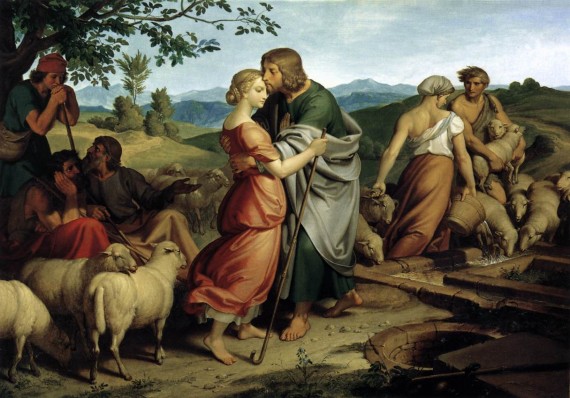
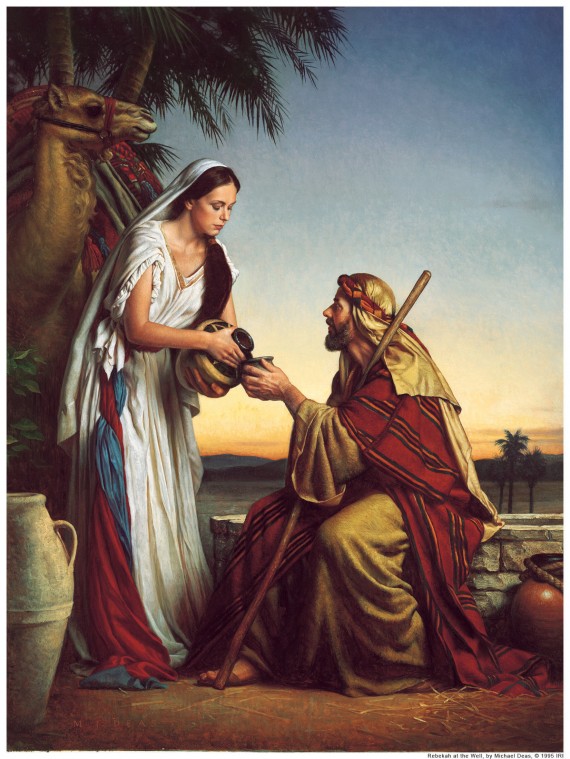
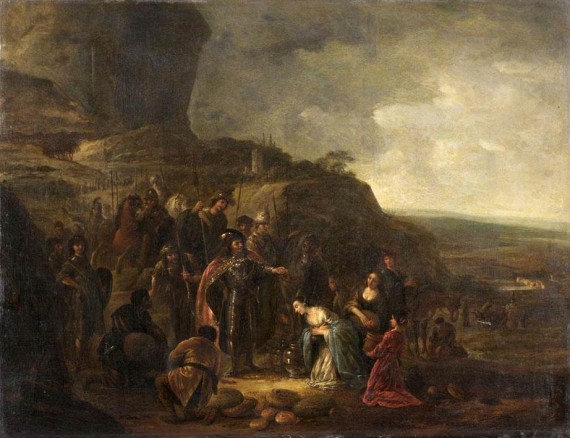
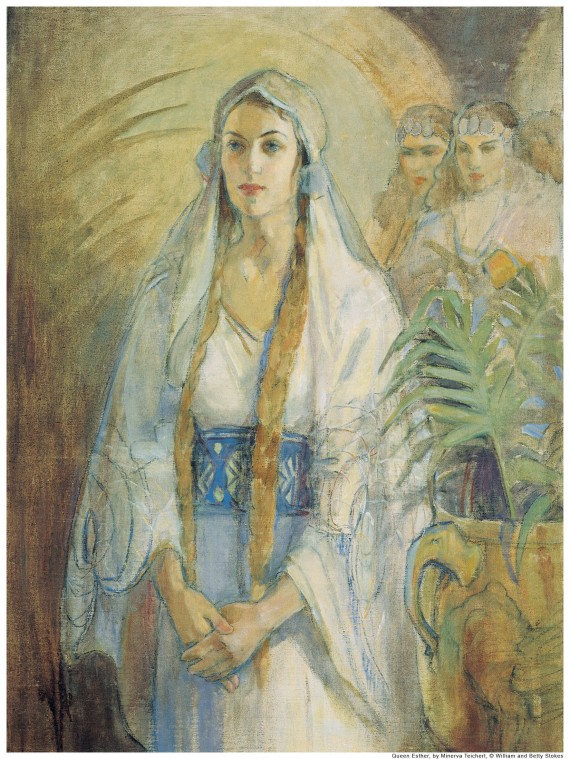

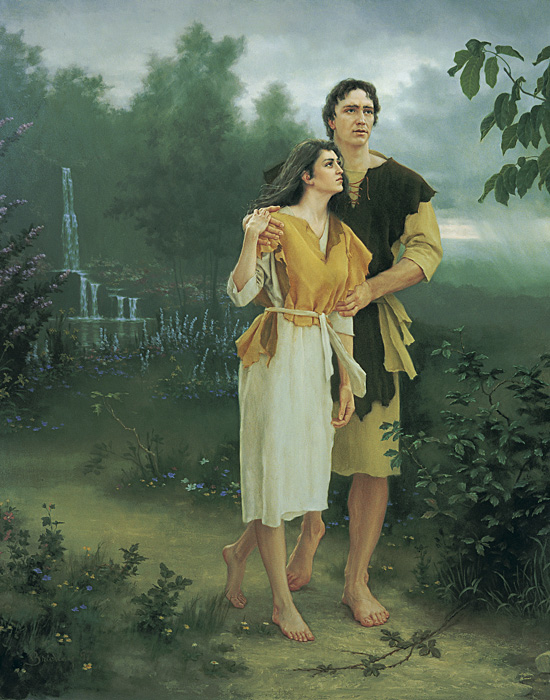
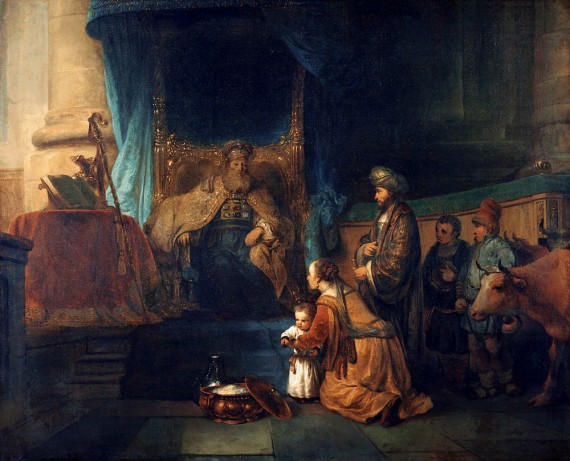
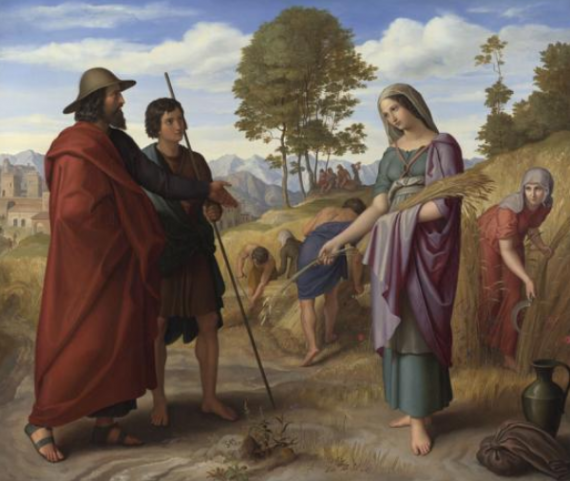
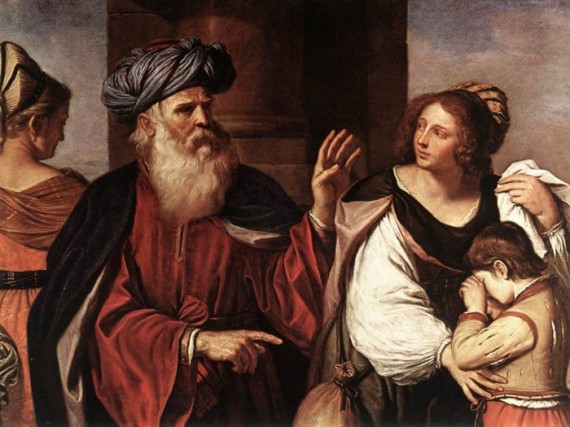
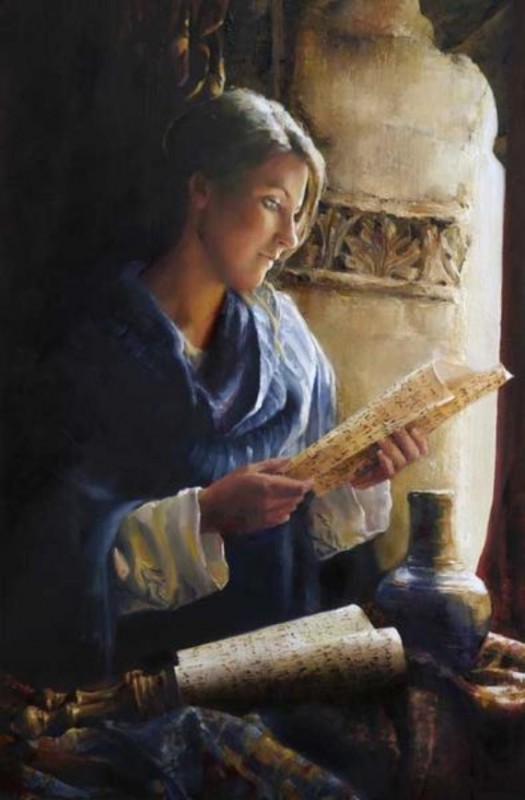
This paintings are amazing. Wow can’t believe what i am seeing right now they are world class.
Excellent post!! Keep it up!
I love these – especially the one of Rebeccah. I love to paint and work in oils. But I am developing a series of “Women of the Hebrew Bible” in pen and ink.
So far I have done Sarah, Miriam and am working Ruth and Jochebed (the mother of Moses).
Yes, the one of Rebekah is a favorite of mine but I guess you knew that because it was included in my post. I like Huldah too, partly because one just doesn’t see Huldah paintings every day.
We would all like to see some of your paintings and sketches. And you have picked a great topic. If ever you want to display some of them you may use my blog as a venue.
Hi Rickety
I am an artist..not Mormon but I have finished several women of the Bible and my goal this year is to do more. I can send you images if you want. So far I have finished Esther, Rebekah, Elizabeth of the New Testament, Jezebel and Deborah. Thanks, Judy Crowe
I couldn’t get them to post here…? not sure why. Maybe my files are too large. Thanks and I enjoyed seeing these old master’s paintings. Great inspiration.
Biographical data for Minerva Teichert is incorrect in stating that she was the first woman artist to receive funding from the church to pursue art studies. She never received any money from the LDS Church to support her art studies. She supported herself by homesteading and teaching school, one of the reasons, it took her longer than she would have liked to develop her craft. Furthermore, the vast majority of paintings now owned by the church were not purchased, but donated to it by her or by members of her family. This is important because it helps those who appreciate her work understand the nature of her devotion to the gospel and her personal “mission.” All of her work was accomplished at great personal sacrifice, in fact she sold cream, butter and eggs raised on the family ranch, in order to be able to purchase art supplies.
I appreciate your feedback with the corrections. I noticed on Wikipedia the claim that Teichert was called on a mission has been removed since I wrote this post.
Thank you for the clarifications and taking the time to comment. If the information I have posted is still incorrect in any way, please let me know and I will edit it immediately.
The additional insight you wrote about Minerva Teichert makes viewing her art all the more enjoyable. Thank you.
Rebekah at the Well is a relatively recent commissioned piece of art done for the Church.The original painting is in the collection of the Museum of Church History and Art where on occasions it is displayed. It is a noteworthy illustration much in the attitude and to the quality of the old masters. One can feel in this painting that something important is happening beyond a woman serving a thirsty desert traveler and his camel(s) much needed water. I sense that Michael Deas approached this ” assignment” with a great desire to employ his considerable skills to create as great a piece of art as possible. It seems that he succeeded. I hope my comments and the following profile of the artist are helpful to gaining a further appreciation of this image and the artist who created it,
“Michael J. Deas is one of the nation’s premier illustrators, combining a “sense of grace and serenity” (in the words of Communications Arts Magazine) unrivaled by today’s realists. His superb eye and phenomenal control of the oil medium has earned him numerous awards and citations, including four Gold Medals and one Silver Medal from the Society of Illustrators. His luminous redesign of the Columbia Pictures logo led to a feature article on the cover of America’s leading graphics publication, Communication Arts, Sept/Oct 1998. The extensive story included more than 15 illustrations, highlighting portraits, advertising art, logos, editorial & book designs, and U.S. Postage Stamps.” (from Michael Deas website)